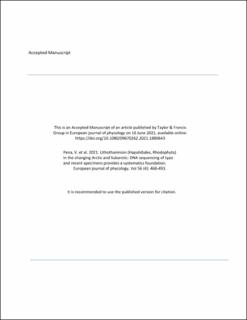Lithothamnion (Hapalidiales, Rhodophyta) in the changing Arctic and Subarctic: DNA sequencing of type and recent specimens provides a systematics foundation
| dc.contributor.author | Peña, Viviana | |
| dc.contributor.author | Bélanger, David | |
| dc.contributor.author | Gagnon, Patrick | |
| dc.contributor.author | Richards, Joseph L. | |
| dc.contributor.author | Gall, Line Le | |
| dc.contributor.author | Hughey, Jeffery R. | |
| dc.contributor.author | Saunders, Gary W. | |
| dc.contributor.author | Lindstrom, Sandra C. | |
| dc.contributor.author | Rinde, Eli | |
| dc.contributor.author | Husa, Vivian | |
| dc.contributor.author | Christie, Hartvig C | |
| dc.contributor.author | Fredriksen, Stein | |
| dc.contributor.author | Hall-Spencer, Jason M. | |
| dc.contributor.author | Steneck, Robert S. | |
| dc.contributor.author | Schoenrock, Kathryn M. | |
| dc.contributor.author | Gitmark, Janne Kim | |
| dc.contributor.author | Grefsrud, Ellen Sofie | |
| dc.contributor.author | Anglès d'Auriac, Marc | |
| dc.contributor.author | Legrand, Erwann | |
| dc.contributor.author | Grall, Jacques | |
| dc.contributor.author | Mumford, Thomas F. | |
| dc.contributor.author | Kamenos, Nicholas A. | |
| dc.contributor.author | Gabrielson, Paul W. | |
| dc.date.accessioned | 2022-01-24T11:07:21Z | |
| dc.date.available | 2022-01-24T11:07:21Z | |
| dc.date.created | 2022-01-17T21:58:01Z | |
| dc.date.issued | 2021 | |
| dc.identifier.citation | European journal of phycology. 2021, 56 (4), 468-493. | en_US |
| dc.identifier.issn | 0967-0262 | |
| dc.identifier.uri | https://hdl.handle.net/11250/2838914 | |
| dc.description | Embargo until June 16, 2022 | en_US |
| dc.description.abstract | Coralline red algae in the non-geniculate genera Clathromorphum, Phymatolithon and Lithothamnion are important benthic ecosystem engineers in the photic zone of the Arctic and Subarctic. In these regions, the systematics and biogeography of Clathromorphum and Phymatolithon have mostly been resolved whereas Lithothamnion has not, until now. Seventy-three specific and infraspecific names were given to Arctic and Subarctic Lithothamnion specimens in the late 19th and early 20th century by Frans R. Kjellman and Mikael H. Foslie. DNA sequences from 36 type specimens, five historical specimens, and an extensive sampling of recent collections resulted in the recognition of four Arctic and Subarctic Lithothamnion species, L. glaciale, L. lemoineae, L. soriferum and L. tophiforme. Three genes were sequenced, two plastid-encoded, rbcL and psbA, and the mitochondrial encoded COI-5P; rbcL and COI-5P segregated L. glaciale from L. tophiforme but psbA did not. Partial rbcL sequences obtained from type collections enabled us to correctly apply the earliest available names and to correctly place the remainder in synonymy. We were unable to sequence another 22 type specimens, but all of these are more recent names than those that are now applied. It is difficult to identify these species solely on morpho-anatomy as they can all occur as encrusting corallines or as maerl (rhodoliths). We demonstrate the importance of sequencing historical type specimens by showing that the recently proposed North-east Atlantic L. erinaceum is a synonym of one of the earliest published Arctic species of Lithothamnion, L. soriferum, itself incorrectly placed in synonymy under L. tophiforme based on morpho-anatomy. Based on sequenced specimens, we update the distributions and ecology of these species. | en_US |
| dc.language.iso | eng | en_US |
| dc.publisher | Taylor & Francis | en_US |
| dc.title | Lithothamnion (Hapalidiales, Rhodophyta) in the changing Arctic and Subarctic: DNA sequencing of type and recent specimens provides a systematics foundation | en_US |
| dc.type | Peer reviewed | en_US |
| dc.type | Journal article | en_US |
| dc.description.version | publishedVersion | en_US |
| dc.source.pagenumber | 468-493 | en_US |
| dc.source.volume | 56 | en_US |
| dc.source.journal | European journal of phycology | en_US |
| dc.source.issue | 4 | en_US |
| dc.identifier.doi | 10.1080/09670262.2021.1880643 | |
| dc.identifier.cristin | 1983061 | |
| cristin.ispublished | true | |
| cristin.fulltext | original | |
| cristin.qualitycode | 1 |
Tilhørende fil(er)
Denne innførselen finnes i følgende samling(er)
-
Publikasjoner fra Cristin - NIVA [2148]
-
Scientific publications [1172]
